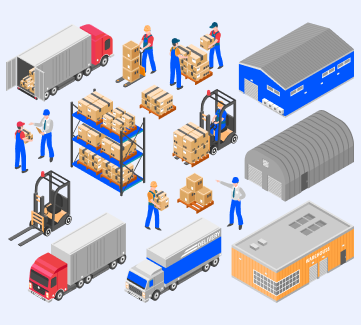In today’s fast-paced business landscape, adaptability and efficiency are paramount. Traditional warehousing models often struggle to keep up with the dynamic demands of modern commerce. However, the emergence of on-demand warehousing offers a transformative solution.
What is on-demand warehousing?
On-demand warehousing is a dynamic platform that links businesses requiring temporary inventory storage and order fulfillment with warehouses possessing surplus space. This approach involves outsourcing fulfillment to intermediaries that coordinate with warehouse providers. Some smaller third-party logistics providers (3PLs) may be involved in this process, while others may utilize non-traditional storage spaces like garages or repurposed buildings. However, this setup raises concerns about the security and reliability of entrusting inventory—an essential component of any business – to third parties procured through intermediaries lacking direct ownership or operation of warehouses. Integrating courier services and selecting suitable types of warehouses are crucial aspects of optimizing on-demand warehousing solutions, ensuring efficient order fulfillment and inventory management while maintaining security and reliability standards.

The Evolution of Warehousing
Historically, companies maintained their own warehouses or relied on third-party logistics providers for storage and distribution. While these models served their purpose, they lacked the agility required to meet fluctuating demand effectively.
Enter on-demand warehousing
On-demand warehousing platforms connect businesses with unused or underutilized warehouse space on a temporary basis. This innovative approach enables companies to scale their storage capacity up or down in response to changing market conditions.
Benefits of on-demand warehousing
Flexibility: on-demand warehousing empowers businesses to scale their operations seamlessly. Whether they need additional space during peak seasons or wish to reduce overhead during slower periods, companies can adjust their storage capacity accordingly.
· Cost-Effectiveness
By eliminating the need for long-term leases and reducing fixed overhead costs, on-demand warehousing offers a more economical alternative to traditional storage solutions.
· Efficiency
With on-demand warehousing, companies can streamline their supply chain operations. By leveraging strategically located facilities and advanced fulfillment software, they can optimize inventory management and distribution processes.
On Demand Warehouse Space
One of the key features of on-demand warehousing is the availability of flexible storage space at short notice, known as on demand warehouse space. Businesses can leverage this capability to meet sudden spikes in demand or accommodate seasonal fluctuations without the burden of maintaining excess capacity year-round.
The Importance of Stock Control
Stock control, also known as inventory management, is a critical aspect of effective warehouse operations. It involves overseeing the levels of goods stored within a facility, ensuring that quantities align with demand forecasts and sales projections. Effective stock control requires careful monitoring of inventory turnover rates, identifying slow-moving or obsolete items, and implementing strategies to minimize stockouts and overstock situations. By maintaining optimal stock levels, businesses can enhance operational efficiency, reduce carrying costs, and improve customer satisfaction by ensuring timely order fulfillment. Advanced inventory management systems and technologies play a vital role in facilitating accurate stock control, providing real-time visibility into inventory levels and streamlining replenishment processes.
Types of Warehouses
On-demand warehousing platforms offer access to various types of facilities, including:
· Traditional Warehouses
These facilities provide standard storage space for a wide range of goods.
· Temperature-Controlled Warehouses
Ideal for perishable items or products requiring specific storage conditions.
· E-commerce Fulfillment Centers
Specialized warehouses equipped to handle the picking, packing, and shipping of online orders.
The Role of Fulfillment Services
In conjunction with on-demand warehousing, fulfillment services play a crucial role in streamlining order fulfillment and distribution processes. These services encompass order processing, buffer inventory management, and last mile delivery tracking, among others.
On Demand Warehousing Companies
Several on demand warehousing companies have emerged to meet the growing demand for flexible storage solutions. These platforms leverage technology to match businesses with available warehouse space, facilitating seamless transactions and distribution management.
Key Considerations for Businesses
When evaluating on-demand warehousing options, businesses should consider the following factors:
· Location
Access to strategically located warehouses can reduce transportation costs and improve delivery times.
· Technology Integration
Platforms that offer advanced fulfillment software and integration capabilities can enhance efficiency and visibility across the supply chain.
· Scalability
The ability to scale storage capacity up or down quickly is essential for accommodating fluctuating demand.
· Security and Compliance
Ensure that selected warehouses adhere to industry standards for security, safety, and regulatory compliance.
Conclusion
On-demand warehousing represents a transformative solution for businesses seeking flexibility, efficiency, and cost-effectiveness in their storage and distribution operations. By leveraging flexible storage space, advanced fulfillment technology, and strategic partnerships with fulfillment centers in Europe and beyond, companies can optimize their supply chain processes and stay competitive in today’s dynamic marketplace. As the demand for on demand storage warehouse solutions continues to grow, businesses that embrace this innovative approach stand to gain a significant competitive advantage.




 Community
Community
